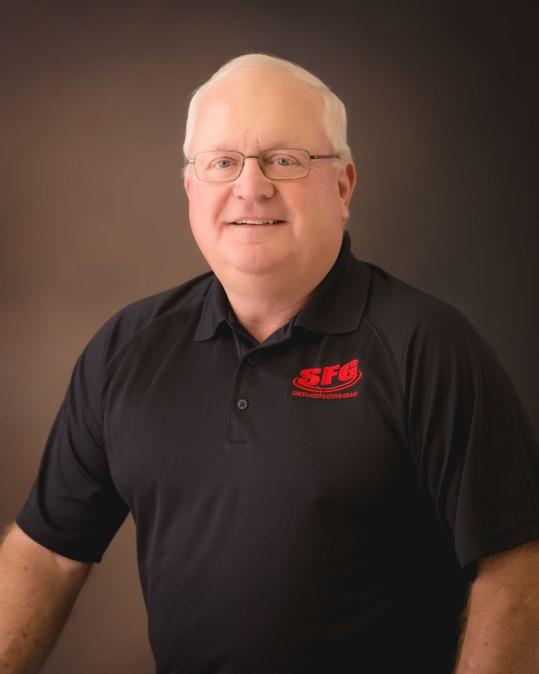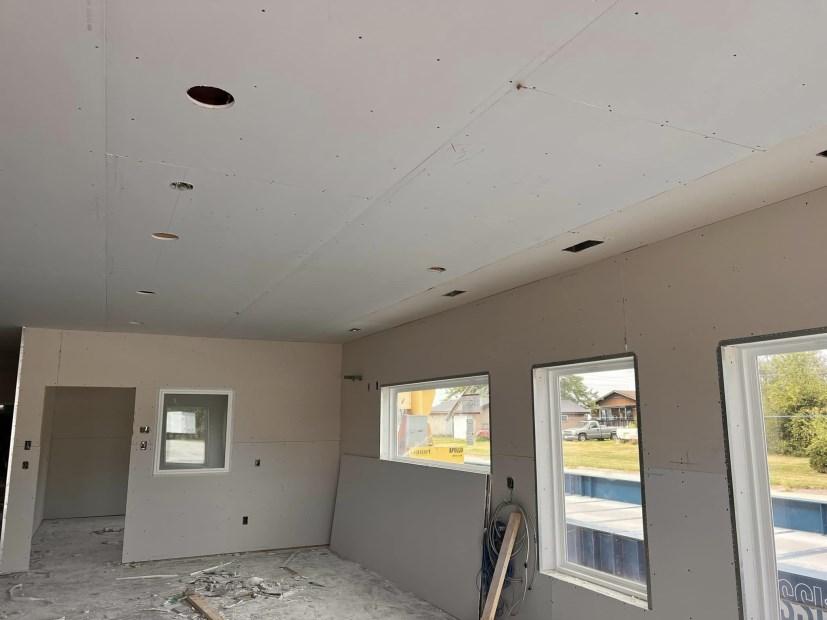InThisIssue:
MarkWhite,GrainManager
CharlesSmith,AgronomyManager
JasonSmith,CentervilleManager
DerrickHoodjer,ProgramsDirector
JasonJensen,AgronomySales
GregWiller,AgronomySales


TaylorBanks,AgronomySales
KevinSmith,ConstructionManager
BrandonBlommers,FeedManager
Grain Update







 Mark White Grain Division Manager
Mark White Grain Division Manager


The finish line for the 2023 crops is in sight. Some early harvest has taken place and most of the corn yields we have seen are very respectable despite the weather we have had this summer. The northern part of our area has produced some very good yields in areas that did not lack for rain this summer. Everyone is anxious to start on the beans and see what kind of yields they will produce. Just about everyone needed a late season rain to finish their beans, but very few in our area got it. The potential was there for a tremendous crop the first of August. Then the heat and dryness sucked a chunk of yield right out the fields. Meanwhile the board of trade has sucked some money out of the grain markets. The September USDA grain report is normally a sleeper. This year it generated a lot of attention. They raised the amount of planted corn 800,000 acres due to late information from the FSA. They did lower the expected yield about what the trade was thinking, but the additional acres kept the carry out above 2.2 billion bushels. They also lowered the bean yield a little compared to their August number, but they also lowered the exports enough that their bean carryout grew just a little. Overall, the bean report was mostly neutral, but the trade has treated it as bearish. So, we are left with lower prices headed into the heat of the harvest. Farmers in general have not presold many fall bushels of either crop this year. The trade
knows this, and you can bet they will attempt to keep prices depressed into harvest knowing that farmers will need to sell some crop off the combine. The opportunity to sell corn at profitable levels will be hard to come by. The crop we are harvesting was the most expensive crop we had ever planted. Now we are looking at corn prices 2.00, or more, less than last year. If you have money borrowed the interest cost is higher and there isn’t enough carry in the market to pay that additional cost to hold. So, after 2 years of somewhat easy marketing, we are in a different situation this year. We are learning that the varieties and hybrids we plant are super resilient compared to years past. That is good when you encounter tough weather, it is bad in that it makes a short crop nationally or globally harder to come by. Our goal every year when we plant is to raise the biggest crop possible. Farmers worldwide share this goal, and we do all we can to make it happen. We will soon know the results of our efforts for this crop. As always, I invite you to call and discuss different strategies. I do not have all the answers, but we can go over some ideas. Our grain locations will run longer hours during harvest. Stay in touch with your location so they know what you need from them.

SFG Operations Update









 Charles Smith Agronomy Operations Manager
Charles Smith Agronomy Operations Manager

won’t be long before it’s time to apply fall anhydrous.
We have gone through all our spraying equipment and put it away for the season. We’ve got our lime and dry fertilizer machines ready for fall field work. As soon as the crops are out, we’re ready to go. If you have lime that you are thinking of applying let us know and we’ll get you on the list.
Once again, the summer growing season has come and gone. We are now getting into the swing of harvest. Several farmers in our area are starting to shell corn. From what I hear they are happy with the yields so far. It looks like in another week some beans will be ready to pick. Let’s hope they are better than expected also.
Our summer construction work at SFG is winding down. The last job at Milo was to complete the office counter system. We have gone through and rebuilt the entire layout. Sara will now have a built-in desk and grain grading area. This will allow someone to jump in and help as needed. This will be the last big improvement there for the season.

Pleasantville is just finishing up their improvements as well. New flooring has been installed on both levels of the office. It sure looks nice with flooring and windows. We now have it all put back together and ready for harvest.
Over the summer we went through our NH3 wagons and tool bars. This was a big project, but it’s worth knowing they’re ready to go. It

New Centerville Office Update

 Jason Smith Centerville Location Manager
Jason Smith Centerville Location Manager












As with the last article, the big news at Centerville is our new office building. Recapping what was said last month, this will be an all-in-one building with warehousing for feed and agronomy, chemical mixing, and equipment storage. This will be a big improvement from our current situation and will absolutely help us service the community better. We hope to be partially moved in by early October, and fully-moved by the end of that month.
Harvest will be here before we know it. We’ve started seeing some sporadic grain coming in. So far no beans, but lots of 25% corn. From what we hear the beans aren’t far off. I would wager we’ll see beans before the end of September. With that said, we are still open for business while the new office building is under construction. You will scale in on the new scale as last year, but pick up your ticket in the old office building until we get moved over. If you have any questions on the grain receiving process, give us a call at 641-856-2828 or 641-891-6070.
We look forward to working with you this fall to receive your grain. We’ll have extended hours through harvest to help you get finished up. We will post the hours where you can see them and make sure to tell you when you’re hauling in grain. If the weather changes or it’s slow, make sure to check with us to see if hours have changed that day.

Central Region Update
Derrick Hoodjer, Agronomy Programs Director

At SFG we always make it a point to be on the cutting edge in technology, providing the most upto-date service to our customers. We are always looking for a new piece of the puzzle that will increase yield. Over the past couple of years, we have promoted using variable rate application of both NH3 and Dry Fertilizer based on yield zones. The idea is to put more fertilizer on in areas of the field that can handle high fertility and will therefore provide a greater return on investment. We have many areas of our fields that can push high yields, as well as areas that need to have fertility reduced based on factors we can’t control.
For example, our custom NH3 applicators can change the rate of nitrogen on demand throughout the field. Using maps built using computer analysis, we will add more nitrogen in the higher yielding areas based on a yield map from the combine. The attached figure shows an example of a variable rate NH3 application map. This map used yield data from the bast 5 years to put together the areas that, on average, yield higher than other areas in the field. The blue is the high yield, and the red is the lower yield.

There is a cost associated with this technology, but it does not generally increase the amount of fertilizer used. If 180lbs of nitrogen is the desired









rate, generally these VRT maps will average 180lbs but will have 200lbs of nitrogen on the good parts of the field and 160lbs nitrogen on the tough parts of the field.
There is a $2/ac cost to build the maps, but it is very easy to see a return on that added cost. On tougher parts of the field, we are saving fertilizer that the ground simply can’t utilize efficiently. On better parts of the field where the soil can make use of it, we are pushing in more NH3. Adding 20lbs of nitrogen to good parts of the field should bring 10+ bushels if there are no other yield limiting issues.
SFG is a believer in variable rate technology and will continue to bring these new capabilities to our customers. Reach out to see if there are some opportunities on your farm to improve the nitrogen program and add in some new technology for 2024.
Have a safe harvest and don’t be afraid to call on SFG for help on your farm today.

Northwest Agronomy Update
 Jason Jensen Northwest District Agronomy Sales
Jason Jensen Northwest District Agronomy Sales

The 2023 crop growing season is rapidly coming to an end and harvest is beginning. As we harvest, it is a good time to look around our fields. Which products boosted yield? What products increased plant health and standability? Some observations that I have noted are the following.
Fungicide on corn and its relationship to tar spot. Corn treated with fungicide is much healthier and shows far fewer lesions than untreated fields of similar hybrids. I have also noted that early planted corn shows more tar spot symptoms than the later planted corn. It will be interesting to follow this to yield and see if any yield loss may have occurred. The question for future years will most likely change from if we see tar spot to when. This is a disease that we are all still learning about.
Soybean health and fungicide. Many soybean fields treated with fungicide handled stress much better than those that were not. Beans stayed green longer, with some appearing to not lose many leaves at all. This should translate into improved yield, but the combines will tell the story. Weed control seems to be excellent on all fields that were sprayed with a good pre and followed up with a good post.
Fields that had ample nitrogen, phosphate, and potash, along with micros, looked to stay heathier.









Moving into harvest, corn looks good in the northwest area for the most part. Soybeans have looked good until the last few weeks. Recently we’ve seen some diseases appear, along with some heat stress.
Talk to your local SFG agronomist about getting ahead of the curve for next year and starting your agronomy plan off on the right foot with adequate amounts of nitrogen, phosphate, potash, and micronutrients. Have a safe and bountiful harvest!

Northeast Agronomy Update
Greg Willer Northeast District Agronomy Sales


The rain we received last week slowed down the harvest for one day, then farmers were back in the fields the next. So far yields have been better than expected. Over the last couple weeks I have been out doing yield checks and checking standability in corn. As many know, tar sport was a concern over the growing season in corn this year. Fields that were treated with a fungicide seem to be holding up better than non-treated fields. The treated fields also seem to be standing better, which should make harvesting that field go more smoothly. Some fields were even treated with a fungicide twice and those fields seem to have very few issues at all. Unfortunately, tar spot seems to be an increasing problem in this area. It may come to a point where every acre of corn will need to be treated with a fungicide to slow down infections. While corn is doing very well in the area, growers are a little pessimistic about beans. The beans looked great all summer, but we did not receive that much needed rain in middle to late August. While walking beans I noticed a lot of the top pods were aborted or very small. There seem to be a lot of pods that are not filled out the best. Not too many beans have been harvested yet so only time will tell. The late-planted late-season beans seem to be in a little better shape. The last rain we
received may add a few bushels to the field, but it may have come a little too late. Only the yield monitor will tell.
The next couple of months will go by in a hurry. Have a safe and bountiful harvest.

HARVEST
VARIABLE











 BUSHELS CALVING CARRYOUT CONSTRUCTION DEMOLITION DITCHER
HYBRID MICRONUTRIENTS
BUSHELS CALVING CARRYOUT CONSTRUCTION DEMOLITION DITCHER
HYBRID MICRONUTRIENTS
NITROGEN TECHNOLOGY TRACKHOE
Southern Agronomy Update
As we get into harvest it is a good time to review the year and make notes of what worked well and what didn’t. For example, some varieties may have handled the wind damage better than others. Information like this can be helpful in the future.
Taylor Banks Southern District Agronomy

Sales
Over the past week harvest has started to pick up in my area. Early reports have the corn coming out in the 21-25% moisture range and I’m hearing yields have been better than expected. Just from what I have seen in my travels I think there should be some soybeans close to ready to harvest in a week or so, with a lot more the following week.
Fall is also an excellent time to get fertilizer and lime on. Here at Centerville we’ve been making arrangements to get lime started as soon as possible. At SFG we have the capability to spread lime conventionally or by GPS grids. If you’re unsure how much lime to apply, we offer soil testing for both application methods.

Finally, cover crops. These have been becoming more popular in recent years. There are numerous cost-share programs through both government and private entities to make these programs very affordable. We have a full line of cover crop seed in stock. If this is something you are interested in, give us a call!
Grandma’s Corn Fritters

Ingredients:
3 cups oil for frying
1 cup sifted all-purpose flour
1 teaspoon baking powder
½ teaspoon salt










¼ teaspoon white sugar
1 large egg, lightly beaten
½ cup milk
1 tablespoon shortening, melted
1 (12 ounce) can whole kernel corn, drained
Directions:
Heat oil in a heavy pot or deep fryer to 365 degrees
Combine flour, baking powder, salt, and sugar in a medium bowl. Beat egg, milk, and melted shortening together in a small bowl. Stir egg mixture into flour mixture. Stir in corn.
Working in batches, drop fritter batter by spoonfuls into the hot oil. Fry until golden.
Remove fritters with a slotted spoon and drain on paper towels.
SFG Construction Update
Kevin Smith
SFG Construction Manager












As we start to approach harvest a lot of you may already be thinking about some of the improvements that you may be wanting or needing to do on your farm. If you are like me, when you get out there in the field, you tend to find those areas in the field that might need some attention.

Fall normally can be one of the best times to get your fields fixed up. We’ve recently added a Wolverine Rotary Ditcher to our toolbox that makes quick and easy work out of reshaping waterways and ditches. We also have a tiling machine to help with drainage, along with trackhoes and bulldozers for heavy dirt and demolition work.
If you have any questions or problem areas on your farm that might need some attention whether that be tiling out those wet spots, putting in terraces, reshaping waterways, cleaning out old fence rows or even just clearing trees, feel free to reach out to see what we can do to help.




Feed Update
Brandon Blommers SFG Feed Manager


This is my first newsletter article, so first, a quick introduction!








I grew up in Oskaloosa, Iowa, where I live with my wife of almost 20 years and our three children. I’ve been working in the agriculture industry since 2009, managing feed, grain, agronomy, fuel, and propane operations. I spent over 11 years as a grain buyer before transitioning into location management. My background also includes a degree in Business Administration, CDL w/tanker and hazmat, and PCQI Feed certification.
Now, on to feed!
‘Tis the season to be weaning calves! We have CrystaLyx brigade tubs for you. Recommended feeding is one tub per 40 head. Also, be sure to worm your weaned calves coming in. They will have a heavy worm load from pasture. If weened calves have been eating creep, leave them on the creep for 14 days, then switch to a grower mix.

We can help with weaning diets too! A few options would be to feed a complete stress pellet with hay at a rate of one pound per head per day with your grain mix. If you are doing a TMR, mix a half- to third-pound per head per day and add grain mix.
It’s also time to let me know what you have for forages so we can get samples and develop diets. Please give me a weeks’ notice on stress feeds because everyone wants something different.
Give us a call at 641-932-2100 and let us know how we can help your livestock operation!








a Safe Harvest!! From our families to yours...
Have


Knoxville Main Office Pleasantville Location Centerville Location Albia Location 1650 Quebec St Knoxville, IA 50138 702 E. Jasper Pleasantville, IA 50228 1605 S. 24th St Centerville, IA 52544 805 Hwy 5 North Albia, IA 52531 Office: 641-828-8500 Office: 515-848-5000 Office: 641-856-2828 Office: 641-932-2100 Milo Location Columbia Fuel Station 101 1st St Milo, IA 50166 2441 Hwy 14 Columbia, IA 50057 Office: 641-942-6223 Cell: 641-218-4035





















 Jason Smith Centerville Location Manager
Jason Smith Centerville Location Manager












 Jason Jensen Northwest District Agronomy Sales
Jason Jensen Northwest District Agronomy Sales









































